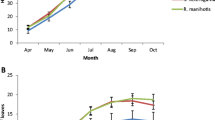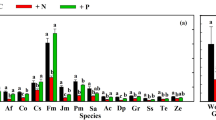Abstract
The objective of this study is to evaluate the field persistence of the edible ectomycorrhizal fungus Lactarius deliciosus in competition with two ubiquitous soil fungi. Couples of plants inoculated with either L. deliciosus, Rhizopogon roseolus, or R. luteolus were transplanted, 10 cm apart, in two different sites at the following combinations: L. deliciosus–R. roseolus, L. deliciosus–R. luteolus, L. deliciosus–control (non-inoculated), control–R. roseolus, control–R. luteolus, and control–control. Eight months after transplantation, root colonization and extraradical soil mycelium for each fungal species were quantified. For mycelium quantification, soil cores equidistant to the two plants in each couple were taken, and total deoxyribonucleic acid (DNA) was extracted. Real-time polymerase chain reaction analysis was performed using specific primers and TaqMan® Minor groove binding (MGB) probes designed in the ribosomal DNA internal transcribed spacer region of each fungal species. Field site significantly influenced persistence of both mycorrhizas and extraradical mycelium of L. deliciosus. Extraradical mycelium quantity was positively correlated with the final percentage of ectomycorrhizas for the three fungal species. Different competitive pressure between the two Rhizopogon species on L. deliciosus persistence was observed, with R. luteolus having no effect on L. deliciosus survival. Negative correlation between the final percentage of mycorrhizas of L. deliciosus and R. roseolus was observed. However, no relationship was determined between extraradical mycelia of both fungal species. The results obtained suggest that competition between L. deliciosus and R. roseolus takes place in the root system, for ectomycorrhiza formation in available roots, rather than in the extraradical phase.

Similar content being viewed by others
References
Agerer R (2001) Exploration types of ectomycorrhizae. A proposal to classify ectomycorrhizal mycelial systems according to their patterns to differentiation and putative ecological importance. Mycorrhiza 11:107–114
Arnolds E (1995) Conservation and management of natural populations of edible fungi. Can J Bot 73(Suppl 1):S987–S998
Bledsoe CS, Tennyson K, Lopushinsky W (1982) Survival and growth of outplanted Douglas-fir seedlings inoculated with mycorrhizal fungi. Can J Forest Res 12(3):720–723
Boa E (ed) (2004) In: Wild edible fungi. A global overview of their use and importance to people. Non wood forest products no. 17. FAO, Rome, (147 pp)
Cairney JWG (2005) Basidiomycete mycelia in forest soils: dimensions, dynamics and roles in nutrient distribution. Mycol Res 109(1):7–20
Chen DM, Cairney JWG (2002) Investigation of the influence of prescribed burning on ITS profiles of ectomycorrhizal and other soil fungi in three Australian sclerophyll forest sites. Mycol Res 106:532–540
Dickie IA, Xu B, Koide RT (2002) Vertical niche differentiation of ectomycorrhizal hyphae in soil as shown by T-RFLP analysis. New Phytol 156:527–535
Egli S, Peter M, Buser C, Stahel W, Ayer F (2006) Mushroom picking does not impair future harvests – results of a long-term study in Switzerland. Biol Conserv 129:271–276
Erland S, Taylor AFS (2002) Diversity of ecto-mycorrhizal fungal communities in relation to the abiotic environment. In: van der Heijden MGA, Sanders I (eds) Ecological studies. Mycorrhizal ecology, vol. 57. Springer, Berlin Heidelberg New York, pp 33–74
Genney DR, Anderson IC, Alexander IJ (2006) Fine-scale distribution of pine ectomycorrhizas and their extramatrical mycelium. New Phytol 170:381–390
Guerin-Laguette A, Plassard C, Mousain D (2000) Effects of experimental conditions on mycorrhizal relationships between Pinus sylvestris and Lactarius deliciosus and unprecedented fruit-body formation of the Saffron milk cap under controlled soilless conditions. Can J Microbiol 46:790–799
Guidot A, Debaud J-C, Effosse A, Marmeisse R (2003) Below-ground distribution and persistence of an ectomycorrhizal fungus. New Phytol 161:539–547
Hall IR, Wang Y, Amicucci A (2003) Cultivation of edible ectomycorrhizal mushrooms. Trends Biotechnol 21(10):433–438
Hortal S, Pera J, Galipienso L, Parladé J (2006) Molecular identification of the edible ectomycorrhizal fungus Lactarius deliciosus in the symbiotic and extraradical mycelium stages. J Biotechnol 126:123–134
Kennedy PG, Bruns TD (2005) Priority effects determine the outcome of ectomycorrhizal competition between two Rhizopogon species colonizing Pinus muricata seedlings. New Phytol 166:631–638
Kennedy PG, Bergemann SE, Hortal S, Bruns TD (2007a) Determining the outcome of field-based competition between two Rhizopogon species using real-time PCR. Mol Ecol 16:881–890
Kennedy PG, Hortal S, Bergemann SE, Bruns TD (2007b) Competitive interactions among three ectomycorrhizal fungi and their relation to host plant performance. J Ecol 95:1338–1345
Koide RT, Xu B, Sharda J, Lekberg Y, Ostiguy N (2005a) Evidence of species interactions within an ectomycorrhizal fungal community. New Phytol 165:305–316
Koide RT, Xu B, Sharda J (2005b) Contrasting below-ground views of an ectomycorrhizal fungal community. New Phytol 166:251–262
Landeweert R, Leeflang P, Kuyper TW, Hoffland E, Rosling A, Wernars K, Smit E (2003a) Molecular identification of ectomycorrhizal mycelium in soil horizons. Appl Environ Microb 69:327–333
Landeweert R, Veenman C, Kuyper TW, Fritze H, Wernars K, Smit E (2003b) Quantification of ectomycorrhizal mycelium in soil by real-time PCR compared to conventional quantification techniques. FEMS Microbiol Ecol 45:283–292
Landeweert R, Leeflang P, Smit E, Kuyper T (2005) Diversity of an ectomycorrhizal fungal community by a root tip and total soil DNA approach. Mycorrhiza 15:1–6
Leake J, Johnson D, Donnelly D, Muckle G, Boddy L, Read D (2004) Networks of power and influence: the role of mycorrhizal mycelium in controlling plant communities and agroecosystem functioning. Can J Bot 82:1016–1045
Lilleskov EA, Bruns TD (2003) Root colonization dynamics of two ectomycorrhizal fungi of contrasting life history strategies are mediated by addition of organic nutrient patches. New Phytol 159:141–151
Mahmood S (2003) Colonisation of spruce roots by two interacting ectomycorrhizal fungi in wood ash amended substrates. FEMS Microbiol Lett 221:81–87
Marx DH, Bryan WC (1975) Growth and ectomycorrhizal development of loblolly pine seedlings in fumigated soil infested with the fungal symbiont Pisolithus tinctorius. For Sci 21:245–254
McAfee BJ, Fortin JA (1985) Competitive interactions of ectomycorrhizal mycobionts under field conditions. Can J Bot 64:848–852
Meotto F, Pellegrino S, Bounous G (1999) Evolution of Amanita caesarea (Scop.: Fr.) Pers. and Boletus edulis Bull.: Fr. synthetic ectomycorrhizae on European chestnut (Castanea sativa Mill.) seedlings under field conditions. Acta Hort 494:201–204
Molina R, Pilz D, Smith J, Dunham S, Dreisbach T, O’Dell T, Castellano M (2001) Conservation and management of forest fungi in the Pacific Northwestern United States: an integrated ecosystem approach. In: Moore D, Nauta MM, Evans SE, Rotheroe M (eds) Fungal conservation. Issues and solutions. British Mycological Society, Cambridge University Press, Cambridge, pp 19–63
Oort AJP (1981) Nutritional requirements of Lactarius species and cultural characters in relation to taxonomy. Serie Ver Km Ned Akad Wet Natuur 76:1–95
Parladé J, Pera J, Alvarez IF (1996) Inoculation of containerized Pseudotsuga menziesii and Pinus pinaster seedlings with spores of five species of ectomycorrhizal fungi. Mycorrhiza 6:237–245
Parladé J, Pera J, Luque J (2004) Evaluation of mycelial inocula of edible Lactarius species for the production of Pinus pinaster and P. sylvestris mycorrhizal seedlings under greenhouse conditions. Mycorrhiza 14:171–176
Parladé J, Hortal S, Pera J, Galipienso L (2007) Quantitative detection of Lactarius deliciosus extraradical soil mycelium by real-time PCR and its application in the study of fungal persistence and interspecific competition. J Biotechnol 128:14–23
Pilz D, Molina R (2002) Commercial harvests of edible mushrooms from the forests of the Pacific Northwest United States: issues, management, and monitoring for sustainability. For Ecol Manag 155:3–16
Pilz D, Molina R, Mayo J (2006) Effects of thinning young forests on chanterelle mushroom production. J Forest 104(1):9–14
Read DJ, Perez-Moreno J (2003) Mycorrhizas and nutrient cycling in ecosystems—a journey towards relevance? New Phytol 157:475–492
Selosse M-A, Jacquot D, Bouchard D, Martin F, Le Tacon F (1998) Temporal persistence and spatial distribution of an American inoculant strain of the ectomycorrhizal basidiomycete Laccaria bicolor in a French forest plantation. Mol Ecol 7:561–573
Singer R (1986) The Agaricales in modern taxonomy, 4th edn. Koeltz, Koenigstein, Germany, (981 pp)
Smit E, Veenman C, Baar J (2003) Molecular analysis of ectomycorrhizal basidiomycete communities in a Pinus sylvestris L. stand reveals long-term increased diversity after removal of litter and humus layers. FEMS Microbiol Ecol 45:49–57
Smith SE, Read DJ (1997) Mycorrhizal symbiosis. Academic, Cambridge, (605 pp)
Villeneuve N, Le Tacon F, Bouchard D (1991) Survival of inoculated Laccaria bicolor in competition with native ectomycorrhizal fungi and effects on the growth of outplanted Douglas-fir seedlings. Plant Soil 135:95–107
Wang Y, Hall IR (2004) Edible ectomycorrhizal mushrooms: challenges and achievements. Can J Bot 82:1063–1073
Wu B, Nara K, Hogetsu T (1999) Competition between ectomycorrhizal fungi colonizing Pinus densiflora. Mycorrhiza 9:151–159
Acknowledgments
The authors wish to acknowledge the financial support provided by the Instituto Nacional de Investigaciones Agroalimentarias (INIA, Spain), project RTA04-029, and the European Regional Development Fund. The work is part of the doctorate of S. Hortal financed by the Departament d’Educació i Universitats de la Generalitat de Catalunya and the European Social Fund. Technical advice of Ramón Seminago and Amaya Amador from the Unitat de Genòmica, Serveis Cientificotècnics, Universitat de Barcelona, is appreciated.
Author information
Authors and Affiliations
Corresponding author
Rights and permissions
About this article
Cite this article
Hortal, S., Pera, J. & Parladé, J. Tracking mycorrhizas and extraradical mycelium of the edible fungus Lactarius deliciosus under field competition with Rhizopogon spp. Mycorrhiza 18, 69–77 (2008). https://doi.org/10.1007/s00572-007-0160-3
Received:
Accepted:
Published:
Issue Date:
DOI: https://doi.org/10.1007/s00572-007-0160-3




